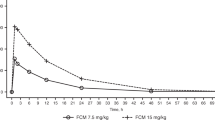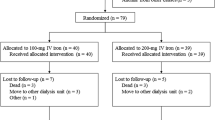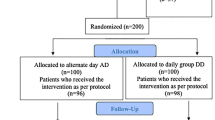Abstract
Intravenous iron is necessary for optimal management of anemia in patients receiving hemodialysis and is utilized in the majority of these patients in the US. The availability of nondextran formulations of intravenous iron has significantly improved the safety of its use. The nondextran iron formulation sodium ferric gluconate complex (SFGC) has been extensively studied in the hemodialysis population, with two large phase IV trials documenting its safety. SFGC is efficacious and, at recommended doses, is associated with a low incidence of adverse events. There have been few comparative studies of the nondextran intravenous iron preparations; however, they are known to have different pharmacokinetic characteristics. There is also evidence to indicate that these compounds differ in terms of their cytotoxic and proinflammatory properties, and their propensity to induce oxidative stress. This paper reviews the current literature on the safety of SFGC and examines the emerging safety issues surrounding the use of intravenous iron.
Key Points
-
The nondextran iron formulation sodium ferric gluconate complex (SFGC; Ferrlecit®) was approved by FDA priority review in 1999
-
Phase IV data support the safety of SFGC for management of anemia in adult and pediatric hemodialysis patients
-
SFGC is associated with a reduced risk of anaphylactoid reactions compared with iron dextran formulations
-
Studies of other safety issues associated with SFGC use are ongoing
-
Limited data exist on the use of SFGC in patients with CKD or those receiving peritoneal dialysis
This is a preview of subscription content, access via your institution
Access options
Subscribe to this journal
Receive 12 print issues and online access
$209.00 per year
only $17.42 per issue
Buy this article
- Purchase on Springer Link
- Instant access to full article PDF
Prices may be subject to local taxes which are calculated during checkout


Similar content being viewed by others
References
[No authors listed] (2001) NKF-K/DOQI clinical practice guidelines for anemia of chronic kidney disease: update 2000. Am J Kidney Dis 37 (Suppl 1): S182–S238
Wingard RL et al. (1995) Efficacy of oral iron therapy in patients receiving recombinant human erythropoietin. Am J Kidney Dis 25: 433–439
Markowitz GS et al. (1997) An evaluation of the effectiveness of oral iron therapy in hemodialysis patients receiving recombinant human erythropoietin. Clin Nephrol 28: 34–40
Fudin R et al. (1998) Correction of uremic iron deficiency anemia in hemodialyzed patients: a prospective study. Nephron 79: 299–305
Besarab A et al. (1999) A study of parenteral iron regimens in hemodialysis patients. Am J Kidney Dis 34: 21–28
Centers for Medicare and Medicaid Services (2004) 2004 Annual Report, End Stage Renal Disease Clinical Performance Measures Project. Baltimore, MD: Department of Health and Human Services, Centers for Medicare and Medicaid Services, Office of Clinical Standards and Quality
Fishbane S et al. (1996) The safety of intravenous iron dextran in hemodialysis patients. Am J Kidney Dis 28: 529–534
Hamstra RD et al. (1980) Intravenous iron dextran in clinical medicine. JAMA 243: 1726–1731
Feridex® (ferumoxide injectible solution) label (Advanced Magnetics, Inc. 1997)
Faich G and Strobos J (1999) Sodium Ferric Gluconate Complex in sucrose: Safer intravenous iron therapy than iron dextrans. Am J Kidney Dis 33: 464–470
Fishbane S and Wagner J (2001) Sodium Ferric Gluconate Complex in the Treatment of Iron Deficiency for Patients on Dialysis. Am J Kidney Dis 37: 879–883
Ferrlecit® (sodium ferric gluconate complex in sucrose injection) package insert (Watson Pharmaceuticals 2004)
Seligman P et al. (2000) Fast IV Iron: Sodium ferric gluconate complex (SFGC) is Safe with No “Free” Iron Toxicity. J Am Soc Nephrol 11: A1560
Seligman PA et al. (2004) Single-Dose Pharmacokinetics of Sodium Ferric Gluconate Complex in Iron–Deficient Subjects. Pharmacotherapy 24: 574–583
Agarwal R (2004) Transferrin saturation with intravenous irons: An in vitro study. Kidney Int 66: 1139–1144
Venofer® (iron sucrose injection) package insert (American Reagent Labs 2004)
Parkkinen J et al. (2000) Catalytically active iron and bacterial growth in serum of haemodialysis patients after i.v. iron-saccharate administration. Nephrol Dial Transplant 15: 1827–1834
Kooistra MP et al. (2002) Nontransferrin-bound iron in the plasma of haemodialysis patients after intravenous iron saccharate infusion. Eur J Clin Invest 32 (Suppl 1): S36–S41
Danielson BG et al. (1996) Pharmacokinetics of iron(III)-hydroxide sucrose complex after a single intravenous dose in healthy volunteers. Arzneimittelforschung 46: 615–621
Van Wyck D et al. (2004): Labile iron in parenteral iron formulations: a quantitative and comparative study. Nephrol Dial Transplant 19: 561–565
Infed® (iron dextran injection) package insert (Watson Pharma, Inc. 2001)
Dexferrum® (iron dextran injection) package insert (American Reagent Labs 2001)
Panesar A and Agarwal R (2002) Safety and Efficacy of Sodium Ferric Gluconate Complex in Patients with Chronic Kidney Disease. Am J Kidney Dis 40: 924–931
Allegra V et al. (1991) Iron deficiency in maintenance hemodialysis patients: assessment of diagnosis criteria and of three different iron treatments. Nephron 57: 175–182
Pascual J et al. (1991) Sodium ferric gluconate complex given intravenously for iron deficiency in hemodialysis. Clin Nephrol 35: 87
Navarro JF et al. (1996) Effectiveness of intravenous administration of Fe-gluconate–Na complex to maintain adequate body iron stores in hemodialysis patients. Am J Nephrol 16: 268–272
Taylor JE et al. (1996) Regular low-dose intravenous iron therapy improves response to erythropoietin in haemodialysis patients. Nephrol Dial Transplant 11: 1079–1083
Cortes MJC et al. (1997) Effect of intravenous Na–Fe-gluconate in hemodialysis patients treated with rHuEPO. Nefrologia 17: 424–429
Nissenson AR et al. (1999) Sodium ferric gluconate complex in sucrose is safe and effective in hemodialysis patients: North American Clinical Trial. Am J Kidney Dis 33: 471–482
Michael B et al. (2002) Sodium ferric gluconate complex in hemodialysis patients: Adverse reactions compared to placebo and iron dextran. Kidney Int 61: 1830–1839
Michael B et al. (2004) Sodium ferric gluconate complex in haemodialysis patients: a prospective evaluation of long-term safety. Nephrol Dial Transplant 19: 1576–1580
Schwartz LB et al. (1989) Time course of appearance and disappearance of human mast cell tryptase in the circulation after anaphylaxis. J Clin Invest 83: 1551–1555
Schwartz LB et al. (1987) Tryptase levels as an indicator of mast-cell activation in systemic anaphylaxis and mastocytosis. N Engl J Med 316: 1622–1626
Coyne DW et al. (2003) Sodium ferric gluconate complex in hemodialysis patients: II. Adverse reactions in iron dextran-sensitive and dextran-tolerant patients. Kidney Int 63: 217–224
Rolla G et al. (1994) Systemic reactions to intravenous iron therapy in patients receiving angiotensin converting enzyme inhibitor. J Allergy Clin Immunol 93: 1074–1075
Parnes EL and Shapiro WB (1991) Anaphylactoid reactions in hemodialysis patients treated with the AN69 dialyzer. Kidney Int 40: 1148–1152
Pegues DA et al. (1992) Anaphylactoid reactions associated with reuse of hollow-fiber hemodialyzers and ACE inhibitors. Kidney Int 42: 1232–1237
Warady BA et al. (2005) Sodium ferric gluconate complex therapy in anemic children on hemodialysis. Pediatr Nephrol 20: 1320–1327
Folkert VW et al. (2003) Chronic use of sodium ferric gluconate complex (SFGC) in hemodialysis patients: safety of higher dose (≥250 mg) administration. Am J Kidney Dis 41: 651–617
Javier AM (2002) Weekly administration of high-dose sodium ferric gluconate is safe and effective in peritoneal dialysis patients. Nephrol Nurs J 29: 183–186
Kosch M et al. (2001) A randomized, controlled parallel-group trial on efficacy and safety of iron sucrose (Venofer) vs iron gluconate (Ferrlecit) in haemodialysis patients treated with rHuEpo. Nephrol Dial Transplant 16: 1239–1244
Esposito BP et al. (2002) Labile iron in parenteral iron formulations and its potential for generating plasma nontransferrin-bound iron in dialysis patients. Eur J Clin Invest 32 (Suppl 1): S42–S49
Sengoelge G et al. (2003) Impairment of transendothelial leukocyte migration by iron complexes. J Am Soc Nephrol 14: 2639–2644
Patruta SI et al. (1998) Neutrophil impairment associated with iron therapy in hemodialysis patients with functional iron deficiency. J Am Soc Nephrol 9: 655–663
Zager RA et al. (2004) Parenteral iron therapy exacerbates experimental sepsis. Kidney Int 65: 2108–2112
Feldman HI et al. (2004) Administration of parenteral iron and mortality among hemodialysis patients. J Am Soc Nephrol 15: 1623–1632
Zager RA et al. (2005) Parenteral iron compounds sensitize mice to injury-initiated TNF-α mRNA production and TNF-α release. Am J Physiol Renal Physiol 288: F290–F297
Zager RA et al. (2002) Parenteral Iron Formulations: A Comparative Toxicologic Analysis and Mechanisms of Cell Injury. Am J Kidney Dis 40: 90–103
Zager RA et al. (2004) Parenteral iron nephrotoxicity: Potential mechanisms and consequences. Kidney Int 66: 144–156
Roob JM et al. (2000) Vitamin E attenuates oxidative stress induced by intravenous iron in patients on hemodialysis. J Am Soc Nephrol 11: 539–549
Michelis R et al. (2003) Carbonyl stress induced by intravenous iron during haemodialysis. Nephrol Dial Transplant 18: 924–930
Rooyakkers TM et al. (2002) Ferric saccharate induces oxygen radical stress and endothelial dysfunction in vivo. Eur J Clin Invest 32 (Suppl 1): S9–S16
Shah SV (2001) Role of iron in progressive renal disease. Am J Kidney Dis 37 (Suppl 1): S30–S33
Remuzzi A et al. (1991) Renoprotective effect of low iron diet and its consequence on glomerular hemodynamics. Kidney Int 39: 647–652
Nankivell BJ et al. (1992) Iron accumulation in human chronic renal disease. Am J Kidney Dis 20: 580–584
Alfrey AC et al. (1989) Role of iron in the tubulo-interstitial injury in nephrotoxic serum nephritis. Kidney Int 36: 753–759
Leehey DJ et al. (2005) Sodium Ferric Gluconate causes oxidative stress but not acute renal injury in patients with chronic kidney disease: a pilot study. Nephrol Dial Transpl 20: 135–140
Agarwal R et al. (2004) Oxidative stress and renal injury with intravenous iron in patients with chronic kidney disease. Kidney Int 65: 2279–2289
Sato K and Shiraki M (1998) Saccharated ferric oxide-induced osteomalacia in Japan: iron-induced osteopathy due to nephropathy. Endocr J 45: 431–439
Besarab A (1999) Iron and cardiac disease in the end-stage renal disease setting. Am J Kidney Dis 34 (Suppl 2): S18–S24
Drueke T et al. (2002) Iron therapy, advanced oxidation protein products, and carotid artery intima-media thickness in end-stage renal disease. Circulation 106: 2212–2217
Boaz M et al. (2000) Secondary prevention with antioxidants of cardiovascular disease in endstage renal disease (SPACE): randomized placebo-controlled trial. Lancet 356: 1213–1218
Tepel M et al. (2003) The antioxidant acetylcysteine reduces cardiovascular events in patients with end-stage renal failure: a randomized, controlled trial. Circulation 107: 992–995
Author information
Authors and Affiliations
Corresponding author
Ethics declarations
Competing interests
The authors have participated in clinical research studies funded by, or hold or have held consulting agreements in which they were compensated on an occasional basis for hourly work performed, with no prescribed minimal number of hours, from Watson Pharmaceuticals, Inc, the manufacturer of sodium ferric gluconate complex.
Rights and permissions
About this article
Cite this article
Michael, B., Fishbane, S., Coyne, D. et al. Drug Insight: safety of intravenous iron supplementation with sodium ferric gluconate complex. Nat Rev Nephrol 2, 92–100 (2006). https://doi.org/10.1038/ncpneph0068
Received:
Accepted:
Issue Date:
DOI: https://doi.org/10.1038/ncpneph0068



